Business
Prices of US wheat weaken while Canada’s wheat stocks remain strong
Stocks of US wheat took a turn, attributing it to the winter season and La Niña. Canada’s wheat stocks look promising, making the most out of spring.

Wheat
Chicago Winter Wheat markets and Minneapolis closed a little lower last week, with the most weakness in HRW due to chances for slightly more precipitation for the western Great Plains.
The U.S. remains partly a weather market, with La Niña conditions affecting the production potential for Hard Red Winter areas. The market is noting dry conditions in western Kansas and other parts of the western Great Plains and the La Nina Winter weather forecast. A drought remains in the region and has become serious, especially in Oklahoma and Texas where the crops will soon be leaving dormancy.
The crop has not established itself well due to the dry weather. The state crop reports released a few weeks ago showed that the deterioration has become very serious. New crop ratings should be released this week, and the crop condition should remain generally much below average. All of the reporting states in the Great Plains showed that very little of the crop can be rated in good to excellent condition. A large part of the crop is now rated in poor to very poor condition.
World estimates, in general, remain large and even reduced U.S. production cannot change this fact very much. U.S. prices will need to remain competitive with European and Russian prices to get much business, and U.S. demand is not strong right now. However, Black Sea prices have been firm recently due to currency considerations and some logistical problems in Russia. Russia and Europe are getting some very cold weather now, and some traders expect to hear reports of Winterkill and production losses from both areas this week.
The weekly charts show that both Winter Wheat markets and Minneapolis Spring Wheat markets remain in sideways trends. However, Minneapolis Spring Wheat prices are weak. The crop in Canada seems to be bigger than any trade estimates, so more Spring Wheat is available to the market. The market also anticipates increased planted area for Spring Wheat this year due to the potentially very short Winter Wheat crop in the U.S.
Weekly Chicago Soft Red Winter Wheat Futures
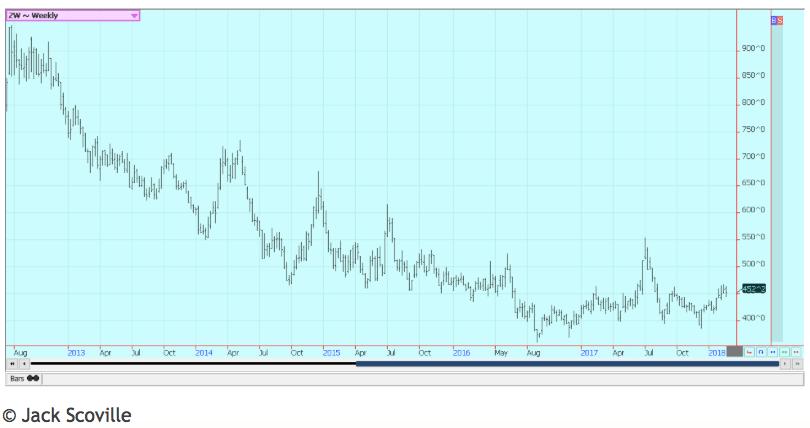
Weekly Chicago Hard Red Winter Wheat Futures

Weekly Minneapolis Hard Red Spring Wheat Futures

Corn
Corn closed slightly lower for the day on Friday and also for the week. Oats were lower and have turned trends down. Ideas are that oats can now move to about 250 and then 234 May. Corn remains mostly a demand market. The weekly export sales report was strong and the sales pace is still well above USDA projections for the marketing year.
Ethanol demand also remains very strong. The U.S. dollar appears to be in a longer-term downtrend, so additional export demand is possible and is appearing. More demand is also possible due to the problems in South America due to the weather.
Brazil is not offering corn and appears to be sold out while Argentina is struggling with dry weather problems of its own that are being caused by La Niña. Brazil has been too wet in central and northern areas to get the corn planted well.
Overall demand for other feed grains such as sorghum and oats is strong, although sorghum demand ideas got hurt when China announced an investigation into imports of U.S. sorghum. China has been a very strong buyer of U.S. sorghum. U.S. farmers have reportedly sold quite a bit corn on the rally as they have held the corn in farm storage for too long. These sales prevented futures from working any higher last week and have been reasons to turn the short-term trends to sideways. Not much if any selling is reported in South America.
Weekly Corn Futures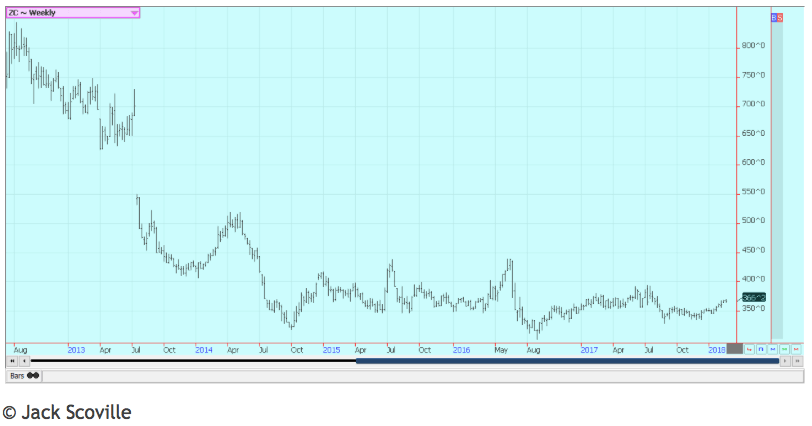
Weekly Oats Futures
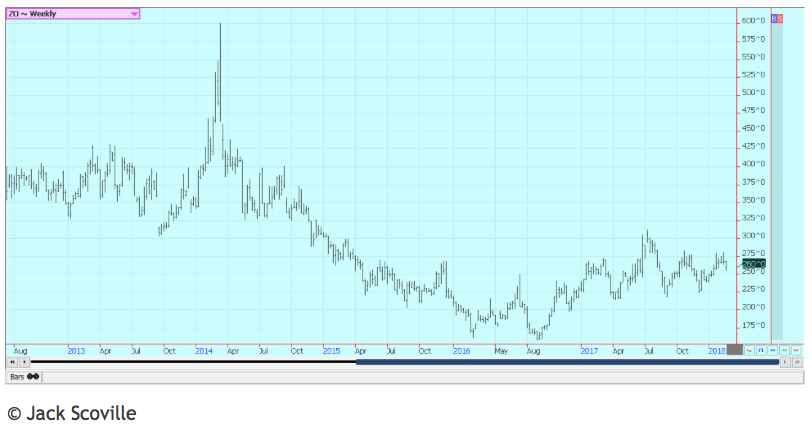
Soybeans and Soybean Meal
Soybeans and soybean meal were higher last week. Futures prices remain supported due to high prices in South America that have come from the drought in Argentina. Significant corn production potential has already been lost in that country, and more dry weather now in the forecast implies that soybeans production losses will be significant as well. However, the potential production losses have not really resulted in a lot of new export business for the U.S., although some new business has been seen in the products.
Current crop new export sales were net negative last week. The low export sales total for the week once again highlighted the fact that U.S. soybeans prices have been stronger lately and also highlighted talk of quality concerns in U.S. soybeans.
U.S. and world crushers are having trouble extracting enough protein from the soybeans while processing for soybean meal, with the meal often showing about 46 percent protein instead of the required level near 48 percent. Stronger domestic demand has helped support soybeans and soybean meal.
Ideas that soybeans production in Argentina are still suffering from dry weather are still support prices in the market, but production estimates for Brazil remain high at near 114 million tons. Some talk of Brazil production at or above 117 million tons.
Argentine production estimates now range from 45 to 50 million tons, from closer to 55 million at the start of the growing season. Forecasts are drier again, with Argentina likely to be the most hurt by any return to hot and dry conditions. Central and northern Brazil are now forecast to get excessive rains this week.
Weekly Chicago Soybeans Futures

Weekly Chicago Soybean Meal Futures
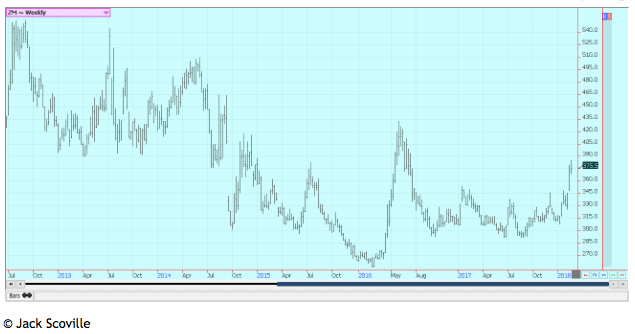
Rice
Rice closed lower on Friday and lower for the week. Prices appear to have turned more stable just above 1200 May futures. Cash market bids remain generally strong amid tight supply availability.
Reports indicate that Texas producers are about to be sold out for the marketing year. Reports indicate that there is a limited amount of rice still owned by farmers in the state, so commercials are raising bids to try to buy what is left.
Limited amounts of rice are reported to be owned by farmers in Louisiana and Mississippi as well. The amount of rice still owned by farmers in Arkansas and Missouri is less clear, but the cash market indicates tight conditions. Cash market traders suggest that the commercials are still short bought, and it looks like they are finally moving to get covered.
Prices for next year are expected to be lower, and USDA showed improved production potential at its Outlook Conference on Friday. Planted area is expected to increase in the coming year, as the tight domestic supply situation has created rather favorable nearby prices.
Weekly Chicago Rice Futures

Palm Oil and Vegetable Oils
World vegetable oils prices were a little higher last week. Palm oil charts show a sideways trend, but trends in soybean oil and canola are up. The trade is looking for palm oil production to continue to decrease in line with seasonal trends, and this expectation has provided the primary support. However, the demand side is very uncertain at this time and has generally been weaker for the last few months.
The Malaysian Ringgit has been moving higher against the U.S. dollar, and this has firmed up prices for palm oil in the world market in dollar terms. Canola markets remain mostly in up trends. Deliveries to elevators have been strong due in part to forward selling earlier in the year. U.S. demand for soybean oil in biofuels should remain strong, and stronger export demand is anticipated due to the threat of reduced production in Argentina.
Weekly Malaysian Palm Oil Futures

Weekly Chicago Soybean Oil Futures
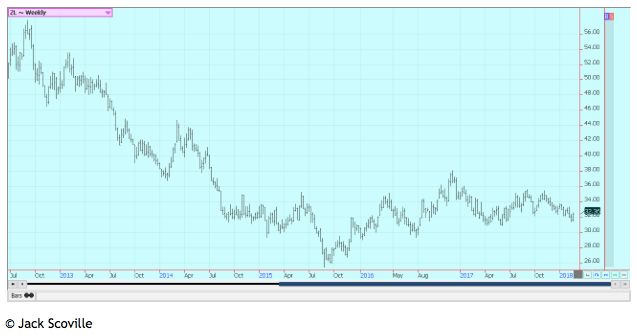
Weekly Canola Futures:
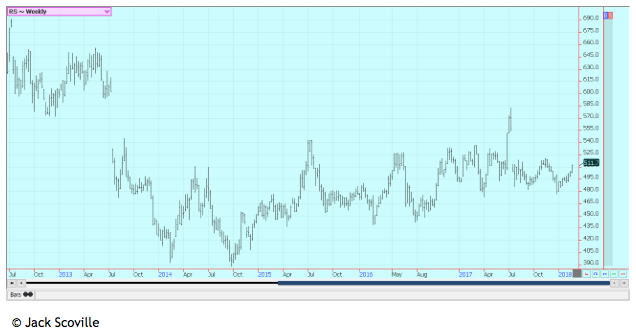
Cotton
Cotton was higher in recovery trading on Friday and posted strong gains for the week. It has been a wild ride for the last several weeks in this market as futures topped, fell back to some big support areas, and now have recovered sharply.
Demand has been strong and merchants have had trouble finding the cotton in domestic cash markets. However, the on call short position held by merchants has been largely erased for now, as merchants have become bigger buyers on the recent price break. Attention will shift to the May position and both May and July feature big on call positions that seem to be getting a little smaller.
The weekly sales of upland cotton showed a significant recovery from the previous week and were considered bullish to prices. The downside could be limited if the U.S. dollar keeps working lower.
USDA showed its projections for the coming year in its Outlook Conference on Friday. Prospective planted area was increased, but not as much as had been anticipated by some in the trade. The production estimate showed that there should be plenty of cotton here, and good supplies were noted in recent production reports.
Prices overall have been much higher than most commercials had expected. Prices could remain strong until closer to harvest. There have also been quality concerns left over from the hurricanes and the freeze during the growing season. USDA expects demand to remain very strong.
Weekly US Cotton Futures
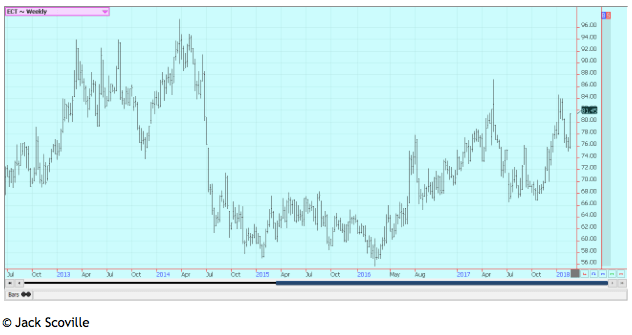
Frozen Concentrated Orange Juice and Citrus
FCOJ was higher on Friday but lower for the week. The rally remains stalled, as the weather has not been threatening in Florida or in Brazil. Trends are still up on the weekly charts, but sideways on the daily charts, and the market is still dealing with a short crop against weak demand.
The current weather is good as temperatures are warm, and it is mostly dry, but the crop is small. The harvest is progressing well, and fruit is being delivered to processors and the fresh fruit packers. Trees in Florida are showing fruit of good sizes, and producers are now into the Valencia crop with the early and mid-harvest completed. Florida producers are actively harvesting and performing maintenance on land and trees. Some early flowering has been reported in the groves, and some fruit is forming. Irrigation is being used.
Weekly FCOJ Futures

Coffee
Futures were mixed on Friday, a little higher for the week in New York, and closed near the lows of the recent trading range. London was slightly lower on Friday and held support areas on the daily charts. London was little changed for the week. Both markets are looking for news to cause a move in either direction.
The charts present a sideways appearance for now and speculators remain very short but have been starting to reduce part of those positions. However, they anticipate big crops from Brazil and from Vietnam this year and have seen no reason to cover the short position in a big way. New York traders are noting the good weather currently being reported in Brazil and expect another bumper crop. However, ideas of a huge crop might now be part of the futures price.
There were reports from London of increased Vietnamese selling, but these were not verified. The Tet holiday is no ending, so offers should start to increase. The situation seems little changed in Latin America. There are reports of short crops in parts of Central America and some areas in South America due to the lack of farmer investment from the low prices. Honduras has been a very active exporter and offers from most other countries are seen. Differentials in Central America are low.
Weekly New York Arabica Coffee Futures
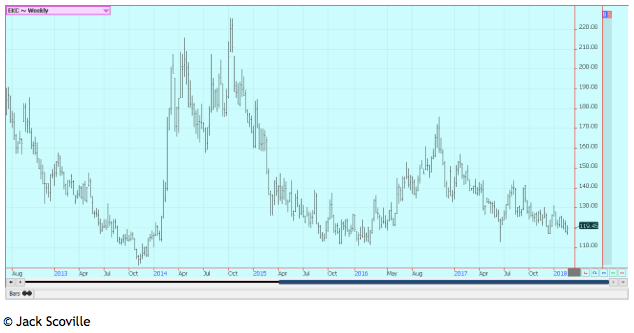
Weekly London Robusta Coffee Futures

Sugar
Futures were a little lower on Friday and higher for the week. Trends are sideways on the daily and weekly charts. London remains at important support areas. The overall feel of the market is that prices for now are cheap enough, but both New York and London appear to need a catalyst to work higher in a big way. Ideas that sugar supplies available to the market can increase in the short term have been key to the selling.
India will export up to 1.0 million tons of sugar this year after being a net importer for the last couple of years. Brazil is considering the end of import tariffs on U.S. ethanol and this has triggered selling in sugar as more cane can now be processed into sweetener. The move comes as ethanol prices in Brazil are very high. It wants lower ethanol prices to help control energy prices in the domestic market.
Mills in Brazil have decided to make more ethanol as world crude oil and products prices have been very strong. Ideas are that these prices can continue strong as OPEC and Russia have agreed to keep production constrained compared to world demand. Even so, there are ideas that world sugar supplies are still enough to meet any demand.
Weekly New York World Raw Sugar Futures
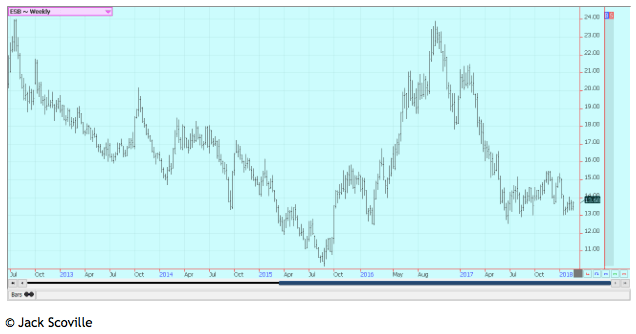
Weekly London White Sugar Futures
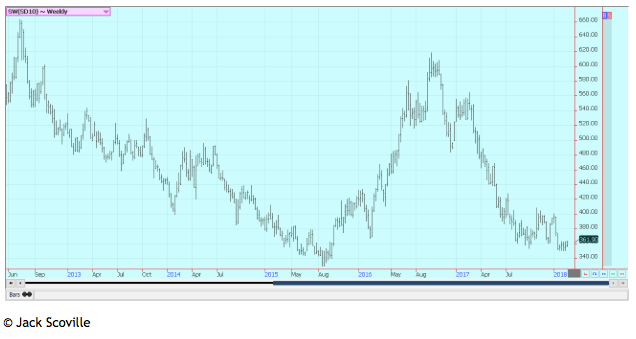
Cocoa
Futures closed higher in New York and in London again on Friday and were higher for the week. Trends are up in both markets on the daily and weekly charts. The market is waiting for the Harmattan winds that can suck moisture from the soil and trees and really hurt bean quality and production. These winds have not developed as of yet, but could at any time. It has become hot and dry in many parts of West Africa, so conditions are good for the winds to form.
Some crop losses might be possible if the current conditions persist even without the winds. The gut slot for offers from the main crop is passing, and the sales by the government suggest that offers down the road can be less. The recent grind data was weaker for North America but positive for Europe and Asia. Demand is not universally strong, but has been improving and is likely to continue to improve as long as prices stay generally weak as processing margins are said to be very strong.
Weekly New York Cocoa Futures

Weekly London Cocoa Futures
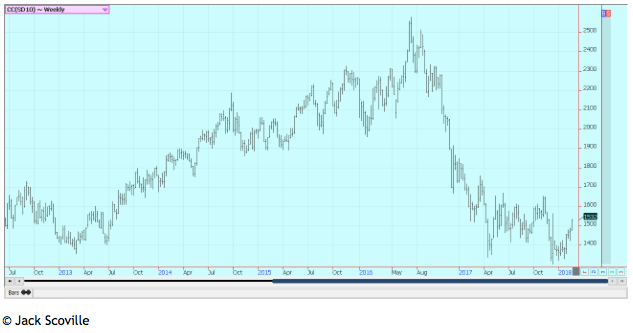
Futures and options trading involves substantial risk of loss and may not be suitable for everyone. The valuation of futures and options may fluctuate and as a result, clients may lose more than their original investment. In no event should the content of this website be construed as an express or implied promise, guarantee, or implication by or from The PRICE Futures Group, Inc. that you will profit or that losses can or will be limited whatsoever. Past performance is not indicative of future results. Information provided on this report is intended solely for informative purpose and is obtained from sources believed to be reliable. No guarantee of any kind is implied or possible where projections of future conditions are attempted.
The leverage created by trading on margin can work against you as well as for you, and losses can exceed your entire investment. Before opening an account and trading, you should seek advice from your advisors as appropriate to ensure that you understand the risks and can withstand the losses.
—
DISCLAIMER: This article expresses my own ideas and opinions. Any information I have shared are from sources that I believe to be reliable and accurate. I did not receive any financial compensation in writing this post, nor do I own any shares in any company I’ve mentioned. I encourage any reader to do their own diligent research first before making any investment decisions.

-

 Crypto6 days ago
Crypto6 days agoCaution Prevails as Bitcoin Nears All-Time High
-

 Africa2 weeks ago
Africa2 weeks agoMorocco’s Wheat Dependency Persists Despite Improved Harvest
-

 Africa2 days ago
Africa2 days agoBridging Africa’s Climate Finance Gap: A Roadmap for Green Transformation
-

 Biotech1 week ago
Biotech1 week agoEcnoglutide Shows Promise as Next-Generation Obesity Treatment


























You must be logged in to post a comment Login